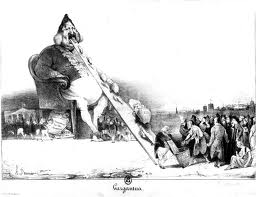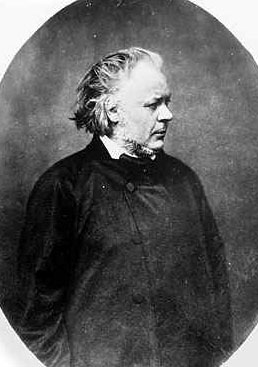Gargantua (caricature)
Date: 1831 1832 1835
Region: Europe
Subject: Political/Economic/Social Opinion
Medium: Mixed Media
Artist: Honore Daumier (1808 - 1879)
Confronting Bodies: The French government under king Louis-Philippe.
Dates of Action: 1831, 1832, 1835
Location: France
Description of Artwork: When Honore Daumier was 24 he was first censored for his caricature of the French king Louis-Philippe. This took place within the first years of the July Monarchy, and the king felt paranoid and insecure in his seat of power. In the caricature, entitled Gargantua, the king is represented as a giant gourmand, a character taken from Francois Rabelais' series of stories, which were themselves censored by the Sorbonne. The fat king sits in front of the National Assembly on a large commode. A huge plank comes out of his mouth on which rewards travel down to the eager officials beneath. Standing around his small, crippled legs are tattered workers and starving mothers who drop coins into the baskets of the ministers.
The Incident: In late 1931 the publishing business La Maison Aubert submitted Gargantua to the "depot legal" for publication and put it on display in the window of the shop. It was soon seized, along with other prints done by Daumier, by the Paris police. They ordered the owner of the publishing house to destroy the lithographic stone and all the remaining proofs. In February 1932 Daumier, the owner of the publishing house, and the printer, were all brought to trial for arousing hatred and contempt of the king's government, and for offending the king's person. In the trial the argument was over whether Gargantua represented the king personally or if it was a symbolic representation of the king's swollen budget. All three of the men were convicted, but only Daumier served a prison term.
Results of Incident: Daumier continued to produce political caricatures, even during his imprisonment and later when he was in a psychiatric clinic. In 1835 the September Laws were passed, which silenced oppositional press, and Daumier and most of his colleagues turned to social caricature.
Source: Censorship: A World Encyclopedia

